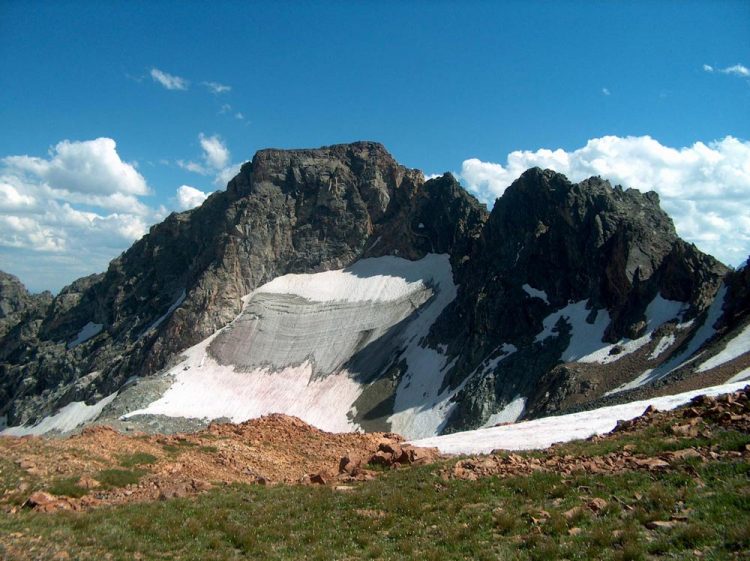Ancient rocks of Tetons formed by continental collisions

Rolling Thunder Mountain near Talus Lake is part of the Teton Range. The orange rock in the foreground is Webb Canyon gneiss, granite formed by decompression melting more than 2.6 billion years ago. Credit: Carol Frost
The research, published Jan. 22 in the journal Geochimica et Cosmochimica Acta, shows that plate tectonics were operating in what is now western Wyoming long before the collisions that created the Himalayas starting 40 million years ago.
In fact, the remnants of tectonic activity in old rocks exposed in the Tetons point to the world's earliest known continent-continent collision, says Professor Carol Frost of UW's Department of Geology and Geophysics, lead author of the paper.
“While the Himalayas are the prime example of continent-continent collisions that take place due to plate tectonic motion today, our work suggests plate tectonics operated far, far back into the geologic past,” Frost says.
The paper's co-authors include fellow UW Department of Geology and Geophysics faculty members Susan Swapp and Ron Frost.
The researchers reached their conclusions by analyzing ancient, exposed granite in the northern Teton Range and comparing it to similar rock in the Himalayas.
The rocks were formed from magma produced by what is known as decompression melting, a process that commonly occurs when two continental tectonic plates collide. The dramatically thickened crust extends under gravitational forces, and melting results when deeper crust rises closer to the surface.
While the Tetons are a relatively young mountain range, formed by an uplift along the Teton Fault less than 9 million years ago, the rocks exposed there are some of the oldest found in North America.
The UW scientists found that the mechanisms that formed the granites of the Tetons and the Himalayas are comparable, but that there are significant differences between the rocks of the two regions.
That is due to differences in the composition of the continental crust in Wyoming 2.68 billion years ago compared to crustal plates observed today. Specifically, the ancient crust that melted in the Tetons contained less potassium than the more recently melted crust found in the Himalayas.
The research was supported by the National Science Foundation.
Media Contact
All latest news from the category: Earth Sciences
Earth Sciences (also referred to as Geosciences), which deals with basic issues surrounding our planet, plays a vital role in the area of energy and raw materials supply.
Earth Sciences comprises subjects such as geology, geography, geological informatics, paleontology, mineralogy, petrography, crystallography, geophysics, geodesy, glaciology, cartography, photogrammetry, meteorology and seismology, early-warning systems, earthquake research and polar research.
Newest articles

“Nanostitches” enable lighter and tougher composite materials
In research that may lead to next-generation airplanes and spacecraft, MIT engineers used carbon nanotubes to prevent cracking in multilayered composites. To save on fuel and reduce aircraft emissions, engineers…

Trash to treasure
Researchers turn metal waste into catalyst for hydrogen. Scientists have found a way to transform metal waste into a highly efficient catalyst to make hydrogen from water, a discovery that…

Real-time detection of infectious disease viruses
… by searching for molecular fingerprinting. A research team consisting of Professor Kyoung-Duck Park and Taeyoung Moon and Huitae Joo, PhD candidates, from the Department of Physics at Pohang University…




















